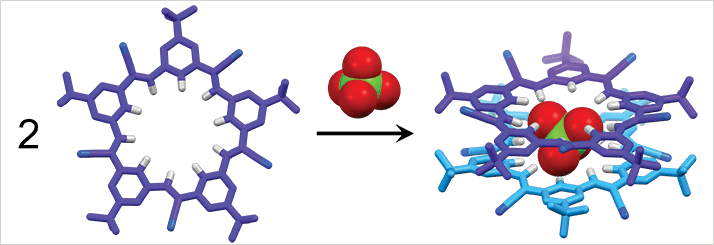High yield, one-pot reactions for macrocycle synthesis are rare. So chemists at Indiana University Bloomington have surprised everyone, including themselves, by easily producing a spectacular new star-shaped cyclic macromolecule, in 10-gram batches (1). According to Amar Flood, associate professor in the Department of Chemistry and corresponding author on the paper, “We performed computer modeling prior to the synthesis – and hoped that the carbonate base might act as a template as much as a catalyst (but) we did not expect such a remarkable yield”.
While macrocycles might be common – even “a dime a dozen” as Flood has noted in the past – cyanostars are special because they capture large charge-diffuse anions previously thought to be only weakly coordinating. “We show that cyanostars bind these ‘weak’ anions with as much tenacity as most ligands bind metals,” Flood explains. “It’s also noteworthy that their five-fold symmetry is rare and it introduces ideas of exotic materials, like quasicrystals.”

Given the ease of cyanostar synthesis and their interesting binding characteristics, commercial use in analytical and preparative separation seems plausible. “Cyanostars may be incorporated into the stationary phase of column support materials to enhance the separation of compounds with negatively charged moieties, such as pendant phosphate, sulfates and acetates,” he says. But he predicts that more likely applications include environmental perchlorate remediation and biological phosphate sensing. “A form of the cyanostar would be capable of binding biological phosphate such as AMP, ADP and ATP, some DNA and RNA, and phospholipids.” To that end, the group is currently examining the cyanostar’s affinity for biological phosphates, after which further customization of the molecular design will be required. “We have experience collaborating with other groups to incorporate anion receptors into polymer membranes for ion-selective electrodes,” Flood says, “and we expect cyanostars to serve as ionophores within such devices to detect environmental or bio-relevant anions.” For more on Flood’s research, visit: www.indiana.edu/~floodweb
References
- Semin Lee, Chun-Hsing Chen & Amar H. Flood, “A pentagonal cyanostar macrocycle with cyanostilbene CH donors binds anions and forms dialkylphosphate [3]rotaxanes”, Nature Chemistry 5, 704–710 (2013). doi:10.1038/nchem.1668
